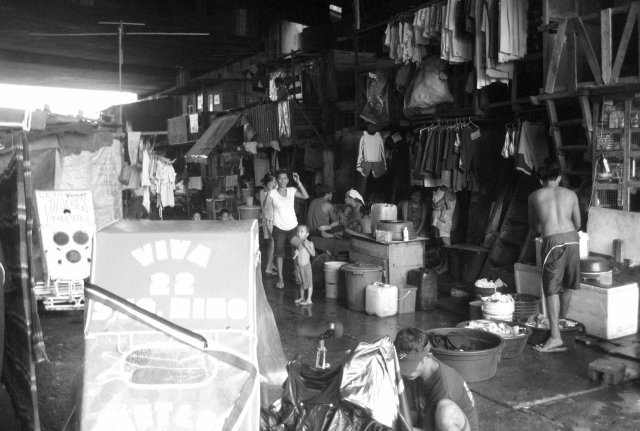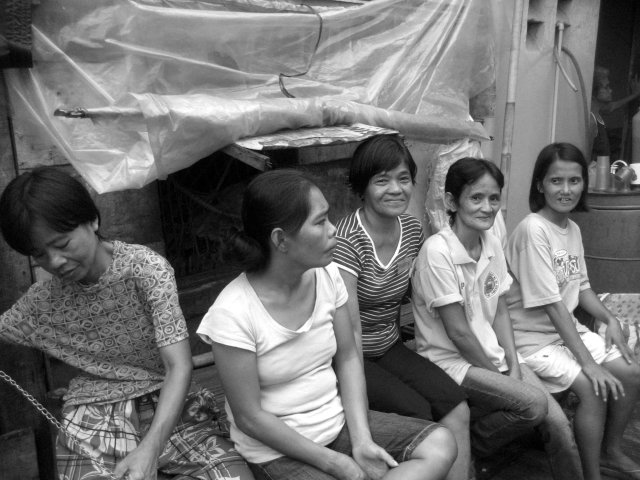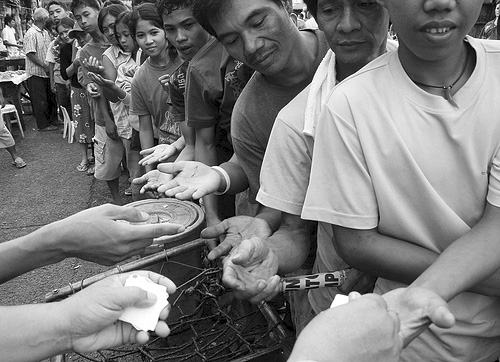 Stories of Survival at the Margins of Manila
Stories of Survival at the Margins of Manila
Del Pan in Manila’s San Nicolas district still exudes a certain charm especially for those who have a keen sense of history, who can see beyond the debris of a war and perennial underdevelopment. Despite the stench coming from the Pasig River, the dilapidated wooden houses and smoke-belching jeepneys, one would appreciate century-old bridges spanning the river, the intricacy of the mother-of-pearl windows, and the very simplicity of travel afforded by the jeepneys and even horse-drawn carriages.
Del Pan’s resiliency is reflected by its women who daily pass through these vestiges of history, who are sometimes not considered constituents (save perhaps during the election season), and who live in the margins—figuratively and literally. Amid the vintage houses, warehouses and container vans lining Del Pan Street are Manila’s poorest who are living in carts and box-like houses. Among them are neighbours Lydia, Susan, and Clarissa.
It is ironic for while the place is supposedly a major dumping ground of both local and imported goods from the nearby ports and barges parked along the river, the households in the neighbourhood usually lack the barest essentials: food. Such necessity was felt even more during the rice shortage in the middle of 2008. Now and then, people rely on dole- outs from the local government, politicians, churches, and civic organisations.
But even before the shortage, these women exhausted every decent means possible to bring food on the table. Their resourcefulness has been the source of their sur vival. Sometimes they feel that with the consistency of sacrifices, they could no longer differentiate a period of shortage from a period of abundance. The latter rarely exists anyway.
 Gambling for Grain
Gambling for Grain
Lydia Sandoval, 38 is a mother of eight children, ages 12, 10, nine, eight, six, four, three and five months.
Although she and her husband are jobless, waking up every morning, worrying about the food they will feed their brood and money for three schooling children, Lydia often finds luck from her mother-in-law and neighbours.
Her mother-in-law maintains a small canteen where she and her husband usually help by fetching buckets of water, running errands, slicing meat and vegetables, or keeping tabs of the packs of rice being sold at the store. Her mother-in-law is among the accredited retailers of the National Food Authority (NFA), the Philippine rice regulator.
It may sound that Lydia has everything within her reach, but in reality, she never demands nor expects anything from the store. “It is known among the neighbours that we have nothing,” motioning to her home. Her home, which measures approximately two by four meters, is too small for a family of ten. At night, her husband and three boys sleep outside on a papag or bed of bamboo slats, which is attached to plastic bench. Asked how they coped with the cold post-Christmas weather, she casually pointed to a roll of thin plastic that functions as an awning.
No, they are not one complacent couple. Lydia’s husband, Angelo is too unqualified even for contractual jobs. Aside from failing to finish high school, Angelo has asthma and a heart disease that limit his mobility. But because of the urgent needs of his family, Angelo would grab every opportunity where he could earn money. He is constantly on the look out for container vans, parking along the curb of the warehouse, just opposite his home. If he is fortunate, he would be among a select group of men who are paid to unload the goods and pile them up inside the warehouse. If he is fortunate, he would be able to collect the spilled food stuff like raw peanuts and sell them in the neighbourhood. If he is fortunate, he would still be fine even if he is exhausted. “Because sometimes, when he experienced heart burn, I had to take him to the hospital,” Lydia explained.
But when times are indeed rough, it is automatic for Lydia’s children to make the most out of the condiments in her tiny cooking space: “They do not complain because they know the situation. If there is really no viand, they would have rice and soy sauce.” Although her family knows how to adapt to worse situations, the recent food shortage caught them quite unprepared.
As the agency tasked to import the country’s rice from Thailand and India and set the price for local production, NFA began rationing the supply of rice: It sent truckloads directly to villages, where every family could only buy five kilos of rice, at the most every day.
This may have ensured an even distribution of a limited good but the problem was cheap rice was only sold once a week. Moreover, not all families had the available money to buy all five kilos whenever there was a chance. NFA rice was sold at PhP18.50 (US$0.39) a kilo, a far cry from the PhP40 (US$0.85) a kilo commercial rice. Price was indeed the only consideration for Lydia and her neighbours, for quality- wise, there was much to be desired from the NFA rice. “The first batches had crushed grains that you could only cook them with little amount of water. It also had a foul odor,” Lydia shared.
Today, Lydia tries to earn extra cash by collecting bets for the gambling game, ending which is based on the last digits of the final scores in a basketball game. Although she still needs to expand her market and has not yet experienced a jackpot, she makes P150 to P200 (US$3.17 to US$4.23) a day. But basketball games are only held thrice a week. Moreover, it takes a few weeks before another basketball season starts.
Rice cakes that sell and save
Two houses from the Sandovals is the home of Susan Lozada, 48. Early on, Susan quipped, “I am in a different situation,” explaining that in her family, she is the breadwinner and not her husband, who broke one of his heels in an accident years ago.
With six children and a husband to feed, Susan was left with no other choice but to further sell kakanin or rice cakes on the side streets of downtown Manila. Although she was used to this work whenever she tried augmenting the family’s budget, she never expected that this would become the only source of income of her family.
Early in the morning, her eldest son would drive her on a rented bicycle to the Tondo district, where she would claim four bilao or winnowing baskets of kakanin, for P1,120 (US$23.69). For every bilao which costs P280 (US$5.92), she expects to obtain a profit of P100 (US$2.12) maximum.
Much of her earnings go to food and the schooling of her four children. Often, nothing is left from her earnings which they could have used for rainy days. However spartan her house is, her water bill is quite big at P700 (US$14.81) a month than a same-sized household with a legal connection, approximately P300 to P400 (US$6.35 to US$8.46) a month. Perhaps this compensates for their electricity bill. Every month, she chips in P50 (US$1.06) to a neighbour that maintains a jumper to the nearest legal metre. But a P50-electricity service means non-stop electricity from 6 pm to 6 am, without any choice of switching off a lightbulb during bedtime.
Like in most families, both lunch and dinner would be heavy on vegetables rather than meat. But sometimes the food is not even enough to be divided among them. “My husband and I had experiences, when after we fed our children, we shared a piece of bread and had coffee and slept. Sometimes we just slept without having supper,” Susan recounted.
The rice shortage was not only felt through the budget crunch but also on the very foodstuff that Susan sells. Before a bilao of rice cake cost P220 (US$4.65). But even as its price soared to P280 (US$5.92), Susan decided to peg a slice at P5 (US$0.11), rather than lose some customers.
Today, Susan’s family is fortunate to have been chosen among the beneficiaries of a church’s feeding prog ramme, which distributes a cup of cooked rice to individuals during lunchtime: “But this is not forever. Right at the beginning, we were already told that this has its limits, so that other people can also benefit [from the programme],” she explained. Although the supply of rice has stabilised in the past few months, the future remains unclear for Susan, particularly when her family is replaced by another family in the feeding programme.
Everything P1
Along the Pasig River, just under a bridge lives a young mother who nurses her son while frying some pancakes for sale. Clarissa de Castro, 28, is among the busy people in the entrepreneur side of Del Pan.
With four children ages 10, eight, six and five months, Clarissa was among the few women who have at least reached tertiary education. Before 5 am, Clarissa is already on the road, purchasing her ingredients and wares. Aside from the tediousness of preparing cheese sticks and pancakes, she is also expected to attend to two children who would be off to school before 11 am, clean the house, do the laundry, prepare dinner, and nurse the baby at certain times of the day — even when her husband is around. The kitchen must be yielding the pancakes, cheese sticks, hotdogs and gulaman, a cold beverage, by early afternoon until 9 pm or until there are no more customers.
Despite the strategic location of the stall, finding the capital to fill the space with goods was not easy. In the end, Clarissa had to source money from Indian lenders referred to as bumbay and their 5/6 system. Repayments are made with 10 per cent interest within 40 days.
Although her stall leaves her less than P200 (US$4.65) a day, Clarissa appears to have a keen business sense, akin to those who conceptualised the “Everything 100” stores in the malls of Metro Manila. Each item such as a pack of tissue papers, t-shirt, teapot and yoga mat sells for P100 (US$2.12). “All my foodstuff cost P1 (US$0.02) a piece because beyond that, it would be difficult for me to give a change. P5 (US$0.11) is already a lot for most. They should also be something that would click,” she remarked.
Her choice of food stuff was not only informed by what could be marketable but also what her children may need: “Before, I sold candies and junk food. Many were buying them however it was difficult to see the profits. Whenever I turned my back, my children would get some stuff but they would not feel full afterwards. At least with hotdogs, even if they consume what I am supposed to sell, they feel full afterwards. Sometimes they don’t feel like having their supper anymore.”
Clarissa’s creativity has indeed saved her children from hunger. It has also become a source of self-respect, even as she admitted sadness over some missed opportunities. “I could have worked abroad but no one would be left for my children…My daughter would have been in London by now since my aunt would like to take care of her but my husband refused.”
Profundity of a Price Crisis
The rice shortage in the market has had a profound effect on women like Lydia, Susan and Clarissa who manage large households. The three women may have been resourceful but behind such creative thinking is actually the instinct for survival.
While they can understand a low harvest because of typhoons, droughts and flooding, nonetheless, they share the belief of most of the country’s population who think that there is so much food and resources available in the ricefields, warehouses, and government coffers. They also share their anger as such resources are made artificially low because of aggressive land conversion where arable lands are turned into subdivisions, poor government support on agriculture and agrarian reform, and hoarding practices. Moreover, the fluctuations of prices in the global market, however contrary to the availability of local resources, is just incomprehensible. Even the Philippine Agriculture Secretary admitted, “We don’t have a food crisis but a rice price crisis.”
During the second quarter of 2008, fuel prices jacked up above US$100 per barrel. In Manila, this became most obvious with an increase of transport fares and later on, prices of commodities. The increasing cost of fuel was followed by the increasing cost of wheat and rice.
Being one of the world’s largest importer of rice, the Philippines had no choice but to pay the price and heavily subsidise tonnes of rice in more than 22,000 accredited dealers and rolling stores nationwide. In February 2008, rice was being traded at US$500 per metric tonne or 54 per cent more than the price in the previous period with US$325 per metric ton. When the government bought some more supplies by the second quarter, the price had already soared to US$1,000 per metric tonne.
 Bigger Problem at Home
Bigger Problem at Home
The prices of fuel may have stabilised at the moment but food and income remain short for Lydia, Susan and Clarissa. Although they are not as stressed as before when they had to queue under the sweltering summer sun for hours, the three women still share an equally pressing challenge. All of them are threatened with demolition as their homes have been illegally built. Lydia’s home stands on what is supposed to be a sidewalk. Susan’s land is being claimed by a prominent family. Clarissa stays on what is considered a danger zone as she lives just a few meters from the
Pasig River. Although all of them deal with stench, clutter, and noise daily, without the benefit of personal space and privacy, Del Pan is still their home.
But they know that they will have to move out sooner or later. As Susan told her neighbours, “Let us not think that we own this land. We are merely stewards of it.” Such personal acceptance is coupled with collective engagement in her desire to secure her rights and the children’s future. The three women are members of a neighbourhood association that constantly dialogues with the government to help ensure a just demolition and decent relocation.
Two years ago both Lydia and Susan were asked to vacate their houses in exchange of P5,000 (US$105.75). The women and their neighbours asked the intervention of certain officials as they refused the offer. But Clarissa was not that fortunate as her house was destroyed in what is considered an illegal demolition as this happened during a raging typhoon. She and her neighbours helped rebuild each other’s homes.
Every day the three women struggle to survive in the city. Every day they work to belong to the city’s future.
Nina Somera thanks the Community Organisers Multiversity. This article is for Lydia, Susan and Clarissa who tirelessly cope and hope.
References:
Cruz, JD. (3 June 2008). “All About the Rice Shortage .”
Interview with Clarissa de Castro on 9 January 2009 in Del Pan, Manila, Philippines.
Interview with Lydia Sandoval on 9 January 2009 in Del Pan, Manila, Philippines.
Interview with Susan Lozada on 9 January 2009 in Del Pan, Manila, Philippines.
IRIN. (27 March 2008). “PHILIPPINES: Rice shortage hits poor as government grapples for solution ”
McCartan, Brian. (31 March 2008). “White Out: Asia’s Rice Price Crisis .”
Remo, Amy R. (12 April 2008). “RP: ‘Rice price crisis, not food crisis .’”





 The
The 
 Isis Resource Center holds one of the largest feminist collections of materials in the Global South. With 40 years of publication experience, Isis holds a vast collection.
Isis Resource Center holds one of the largest feminist collections of materials in the Global South. With 40 years of publication experience, Isis holds a vast collection.